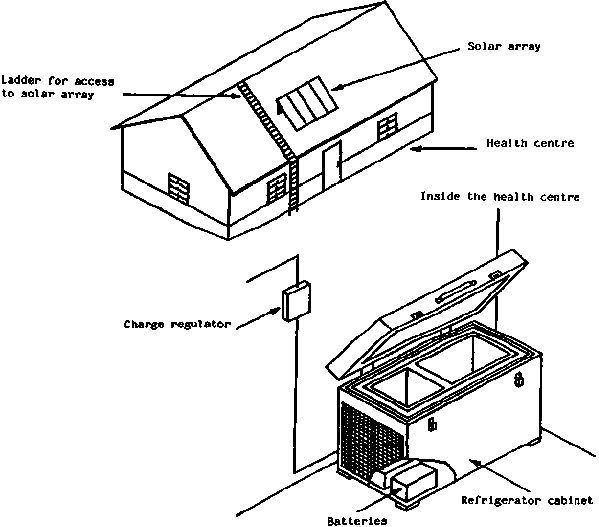Comment réfrigérer les vaccins avec l'énergie solaire photovoltaïque : Différence entre versions
(→Réduction des coûts de fonctionnement en raison de:) |
|||
| Ligne 59 : | Ligne 59 : | ||
<blockquote> | <blockquote> | ||
| − | • | + | • élimination des coûts de carburant de kérosène<br /> |
| + | • élimination des coûts de transport de kérosène<br /> | ||
| + | • réductions des pertes de vaccins<br /> | ||
| + | • coûts inférieurs d'entretien du réfrigérateur <br /> | ||
| + | • besoins réduits pour la réparation des réfrigérateurs où il y a des problèmes d'approvisionnement de carburant. | ||
</blockquote> | </blockquote> | ||
| + | |||
===Cold chain management benefits due to:=== | ===Cold chain management benefits due to:=== | ||
Version du 9 août 2016 à 15:10
Traduction en cours...
Sommaire
Description
- Problème:
- Idée:
- Difficulté:
- Gamme de prix:
- Matériel nédessaire:
- Zone géographique:
- Compétences:
- Combien de personnes?
- Combien de temps?
Introduction
Les programmes de vaccination de grande ampleur sont mondialement en cours de développement dans la lutte contre les maladies transmissibles courantes. Pour être efficaces, ces programmes doivent fournir des services de vaccination dans les zones rurales.
Le rayonnement solaire a tendance à être élevé dans les climats qui ont de grands besoins de refroidissement, beaucoup d'efforts ont été dirigés pour développer des réfrigérateurs à énergie solaire. Bien que certains réfrigérateurs à absorption solaire (thermique)ont été développés, ce sont les réfrigérateurs solaires photovoltaïques (électriques) qui ont jusqu'à présent fait leurs preuves.
L'énergie photovoltaïque solaire pour les réfrigérateurs a un grand potentiel pour réduire les coûts de fonctionnement, une plus grande fiabilité et une plus longue vie que les réfrigérateurs à pétrole ou des générateurs diesel, qui ont été généralement utilisés dans des régions éloignées. Au cours des cinq dernières années, au moins 3000 réfrigérateurs médicaux photovoltaïques ont été installés.
Nécessité
Tous les vaccins doivent être conservés dans une plage de température limitée tout au long du transport et du stockage. La fourniture de réfrigération, connue sous le nom de «chaîne du froid» pour vaccins, est une entreprise logistique important dans les zones où l'approvisionnement en électricité est inexistant ou erratique. La performance des réfrigérateurs alimentés par le kérosène et le gaz en bouteille est souvent insuffisante. Les systèmes de moteur diesel souffrent souvent des problèmes d'approvisionnement en carburant. L'énergie solaire est donc d'une grande importance aux soins de la santé.
Avantages de l'utilisation des réfrigérateurs photovoltaïques
Par rapport réfrigérateurs fonctionnant au kérosène ou au gaz en bouteille, les systèmes photovoltaïques présentent les avantages suivants:
Amélioration des installations de stockage des vaccins en raison de:
• élimination des problèmes d'approvisionnement en carburant
• élimination des problèmes de qualité des carburants
• une plus grande fiabilité du réfrigérateur
• une meilleure performance du réfrigérateur (et contrôle de la température).
Réduction des coûts de fonctionnement en raison de:
• élimination des coûts de carburant de kérosène
• élimination des coûts de transport de kérosène
• réductions des pertes de vaccins
• coûts inférieurs d'entretien du réfrigérateur
• besoins réduits pour la réparation des réfrigérateurs où il y a des problèmes d'approvisionnement de carburant.
Cold chain management benefits due to:
• longer equipment life (photovoltaic array 15 years, battery 5 years, refrigerator 10 years)
• reduced logistical problems arising from non-availability of working refrigerators
• reduced logistical problems arising from lower vaccine losses.
The above operational advantages of introducing solar refrigerators into the cold chain indicate that solar refrigerators can provide a more sustainable vaccine cold chain.
It should be noted however, that as each system is site specific, more time is necessary for planning and implementing a project with solar refrigerators.
User training demands are also higher since a new technology is being introduced.
Comparative costs
A true comparison of solar refrigerators and comparable kerosene and bottled gas fuelled refrigerators can only be made through a life-cycle cost analysis.
A solar photovoltaic refrigerator cabinet only is likely to cost around US $1300 - 2600 (with the complete system costing around US $3000 - 5000) and will cost more to install than a kerosene unit. A kerosene refrigerator will cost only US $650 - 1300 but will use 0.5 - 1.4 litres of fuel per day, require frequent maintenance and have a shorter life. In general, life-cycle costs are approximately the same for solar and kerosene refrigerators, but because of their greater reliability and resultant savings in wasted vaccine, solar refrigerators are the preferred option.
The technology
Refrigerator
Photovoltaic refrigerators operate on the same principle as normal compression refrigerators but incorporate low voltage (12 or 24v) dc compressors and motors, rather than mains voltage ac types. A photovoltaic refrigerator has higher levels of insulation around the storage compartments to maximise energy efficiency, a battery bank for electricity storage, a battery charge regulator and a controller which converts the power from the battery to a form required by the compressor motor.
A typical refrigerator layout is as shown below (Figure 1). Most refrigerators include a freezer compartment for ice pack freezing. Other systems have separate units to provide solely for refrigeration or freezing. Available sizes range between 10 and 85 litres of vaccine storage capacity with ice production rates of up to 6.4 kg per 24 hours.
Batteries
The battery most commonly used is the lead acid type, long life, deep cycle batteries are preferred. A capacity to run the refrigerator for five days without sun is recommended.
Charge regulator
The charge regulator maintains the power supply within the current and voltage range tolerated by the refrigerator and prevents overcharge of the battery. Some models include an audible alarm or warning light to signal when battery voltage becomes low. Lightning surge protection must be provided for tropical areas.
Array and support structure
The solar array can be for roof or ground mounting. The array size for a refrigeration system is calculated to meet the power requirements of the system, given the solar irradiance data for the proposed site. The typical requirement is 150 - 200 Wp of photovoltaic modules.
Performance
The energy consumption of a photovoltaic vaccine refrigerator is typically 400 - 800 watt-hours per 24 hours for a 100-litre refrigerator without icepack freezing and at +32°C ambient temperature. At +43°C ambient temperature and freezing 2kg of ice packs per 24 hours the energy consumption of the same refrigerator would rise to about 900 - 1900 watt-hours per 24 hours. It is very important not to overload a solar refrigerator as this increases energy consumption considerably.
A good vaccine refrigerator should be able to maintain correct internal temperatures for at least ten hours in the event of being disconnected from the battery and solar array.
Costs
The output of a photovoltaic array will vary according to the location at which it is to be installed and the refrigerator energy consumption will depend on local climate. Therefore the size of the solar array, the battery storage capacity and hence the system cost will vary depending on location. Typical system costs are in the range of US $3,500 - 7500 excluding transport and installation.
Products available
The Department of Vaccines and Biologicals of the World Health Organisation, in its Immunisation Systems Series publishes, every two years, a document entitled 'Product Information Sheets'. This catalogues equipment that has undergone tests to verify their performance is of a standard acceptable to the World Health Organisation (WHO) and United Nations Children Fund (UNICEF). The document may be obtained from: The V & B Document Centre, Department of Vaccine and Biologicals, World Health Organisation, CH-1211 Geneva 27, Switzerland.
Website: http://www.who.int/vaccines-documents.
Suppliers
Note: This is a selective list of suppliers and does not imply Practical Action endorsement or promotion.
- BP Solar Ltd., PO Box 191, Chertsey Road, Sunbury-on-Thames, Middlesex TW16 7XA, United Kingdom
Tel: +44 1932 779 543 Fax: +44 1932 762 686
- Dulas Ltd., Dyfi Eco Park, Machynlleth, Powys, SY20 8SX, U.K. Telephone: +44 1654 705 000, Fax: +44 1654 703 000
- Comesse Soudure SA, 88390 Chaumousey, France. Tel: +33 3 2966 8548, Fax: +33 3 2966 8094
The unit supplied is solar thermal and not solar photovoltaic.
- Electrolux (Luxembourg) SARL, 14 op der Hei, L-9808 Hosingen, Luxembourg. Telephone: +352 920 731, Fax: +352 920 731 300
- NAPS Norway A/S, Strandvein 50, N-1366, Lysaker, Norway, Tel: +47 67 112 550, Fax: +47 67 112 545
- Solamatics (Pvt) Ltd., 31 Edison Road, Graniteside, Harare, Zimbabwe. Tel: +263 4 749 930, Fax: +263 4 771 212
- TATA BP Solar India Ltd., Plot No. 78, Electronic City, Hosur Road, Bangalore 561 229, India. Tel: +91 80 852 1016, Fax: +91 80 852 0116
- Norcoast Refrigeration Co, 50 Grigor Street, Caloundra, Queensland 4551, Australia, Tel: +61 7 9491 1849, Fax: +61 7 5491 7627, Website: http://www.norcoast.com.au
- Sun Frost, PO Box 1101, 824 St Ste # 7, Arcata, California 95518, USA. Tel: +1 707 822 9095, Fax: +1 707 822 6213
References and further reading
This Howtopedia entry was derived from the Practical Action Technical Brief Energy from the Wind.
To look at the original document follow this link: http://www.practicalaction.org/?id=technical_briefs_energy
Adresses
Practical Action
The Schumacher Centre for Technology & Development
Bourton Hall, Bourton-on-Dunsmore, Rugby, Warwickshire CV23 9QZ, UK
Tél: +44 (0)1926 634400 Fax: +44 (0)1926 634401 E-mail: infoserv@practicalaction.org.uk Web: http://www.practicalaction.org

Intermediate Technology Development Group Ltd Patron HRH - The Prince of Wales, KG, KT, GCB
Company Rag. No 871954, Angleterre Rag. Charity No 247257 VAT No 241 5154 92
